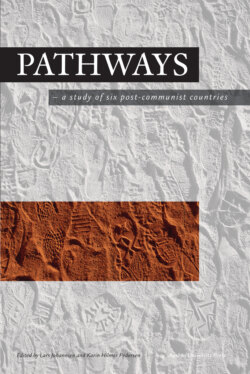Читать книгу Pathways - Группа авторов - Страница 8
На сайте Литреса книга снята с продажи.
Designing political institutions
ОглавлениеTransitions from authoritarianism are frequently analysed with the aid of ‘pacts’ and ‘imposition’ (Karl & Schmitter 1991), highlighting exclusion and inclusion of the communist elite after regime breakdown. The communist elites in Georgia and the Czech Republic were effectively excluded, while Poland and Hungary are the standard examples of negotiated and inclusive East European pacts. An additional distinction, however, is how elites exploited the windows of opportunity that were open only in the early years of reform. Elster, Offe & Preuss (1998, 59-60) argue that such windows could either be ‘invested’ in the creation of new institutions or ‘consumed’ to accumulate power and deal with newly emerging problems on an ad hoc basis. Whereas Hungary, Poland and the Czech Republic illustrate how the windows of opportunity were invested in forming new democratic and economic institutions, the Georgian elite consolidated their power by using state institutions for private ends in a clientelistic network.
Inclusion or exclusion of the communist elite and the way elites operated are reflected in how the new political institutions evolved. At least three aspects are crucial. The first aspect concerns how political decision makers, presidents and parliaments, are chosen. On the one hand, election rules can be so constructed that the incumbent regime can ensure the election of its candidates through appointments to a quota of the Upper House and through stringent membership requirements for parties, which is the case in Kazakhstan. On the other hand, early decisions on election rules can be so liberal that representation becomes fragmented, and thus counterproductive to efficient and viable decision making. Conversely, the choice of an extremely high electoral threshold may effectively exclude significant parts of the population from parliamentary representation as seen in the Czech Republic.
The second aspect concerns how public demands and interests are channelled into political decisions: the development of political parties on the one hand, and that of civil society organisations on the other. Post-communist states are dominated for many reasons by weak and deformed civil societies (Bernhard 1996). Communism not only did its best, at least in theory, to stamp out socio-economic differences; it also attempted to destroy civil society in practice. At the dawn of democracy in 1989 Linz and Stepan (1996, 352) counted the number of independent movements in Poland, Hungary and Bulgaria to be a mere 60, 21 and 13, respectively. Although the number of associations has since increased massively (Ágh 2001; Mansfeldová et al. 2005), Howard (2000) argues that measured by membership, organisations in post-communist Europe remain weak.
The weakness of civil society is correlated with the persistent problems in forming party systems that reflect emerging socio-economic cleavages. The problem is related to a persistent political cleavage along the lines of a postcommunist divide (Kitschelt 1995; Whitefield 2002) and the lack of coherent inter-party and coalition programmes, of which the Polish case is an all too good example. The main problem, not only in the Polish case, is to develop a stable party system to ensure that governments are accountable to the voters through the parties (Rose, Munro & White 2001). Toole (2003) demonstrates that the formation of a modern East-European party tends to be elite-driven and not so much rooted in society; but he also finds (2005) promising signs of decreasing electoral volatility, suggesting that the party systems are in the process of stabilising. Developments in the Czech Republic highlight another problem. Here The Communist Party of Bohemia and Moravia (KSCM) – the last unreformed communist party in Eastern Europe – wins between 11 and 18 per cent of the vote. But because of its extreme leftist position it is not considered a credible government partner. The danger is not so much that government must be formed among centrist forces; the risk is that the KSCM is forced to become, in Linz’s (1978) terms, an anti-systemic and disloyal opposition, and secondly, that a forced coalition between centre and right-wing parties may eradicate political competition (Vachaudova 2005).
The third aspect focuses on the inclusion of civil society actors in decisionmaking processes. Inclusiveness is not merely a question of voice, however. There is empirical evidence that a responsive state, one characterised by dense cooperation between public authorities and a civil society based on values of participatory democracy, has a tendency to be kinder and gentler, promoting equality and reducing poverty (Johannsen & Pedersen 2008). In our country sample, the extended Slovenian corporatist system is a highly inclusive political system (Lukšič 2003), while in contrast, the Kazakhstani political system is based on central management with a largely demobilised civil society in which civil society organisations are mainly seen to monitor society and mobilise behind presidential policies. The remaining countries’ attempts to activate tripartite institutions, partly in response to European Union requests, can be placed somewhere in-between.
